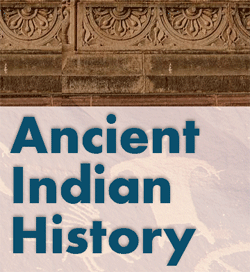IAS Prelims: General Studies (Ancient Indian History) - Mauryan Period (321-184 BC)
Ancient Indian History
Mauryan Period (321-184 BC)
Archaeological Remains
(1) Use of Iron was on a more extensive scale
(2) Northern Black Polished Ware (NBPW) use continued with increase in variety
number and area.
(3) Burnt bricks were used for the first time in the Mauryan period
(4) Ring well were also identified for the first time in the Mauryan Period.
(5) Even in the Mauryan period, we have no evidence of usage of gold coins.
Rupyarupa and Pana were the silver coins whereas Tamarupa were the copper coins
used in the Mauryan period.
(6) Many wooden palaces and halls were unearthed from the Mauryan period.
Kautilya’s Arthasastra: It is the most important Literary source of the Mauryan period. It is a book on political economy. It was written in Sanskrit ,Arthasastra was divided into 15 adhikarnas (parts). It gives us an idea of the functioning of the Mauryan state.
Megasthens’s Indica: Megasthenes was the greek ambassador of Selucus Nikator to the court of Chandragupta Maurya. His book indica is the foremost among all the foreign accounts for Mauryas.
India Buddhist Literature
(a) Jatakas reveal a general picture of socio-economic conditions of the
Mauryan period – Jatakas are stories of previous births of the Buddha.
(b) Digha Nikaya helps in determining the influence of Buddhist ideas on
Mauryan polity.
(c) Vamsathapakasini gives us information about the Kshatriya origin of
the Mauryas.
(d) Arya Manjusri Mool Kalpa, a Buddhist book written later also contains
references to the Mauryans and the Guptas.
Parsistaparvan: It is a book written by Hemachandra. This jaina work talks about the conversion of Chandragupta Maurya to Jainism. He then renounced the thorne in favour of his son, Bindusara and is said to have gone to sharvanabelagola near Mysore, Where he deliberately starved to the death in the approved Jaina fashion.
Vishakhadatta’s Mudrarakshasa: This Book written in the gupta periods deals with the strategies of kautilya and mentions Chandragupta Maurya as being of lowly origin. He calls Chandragupta Maurya as ‘Vrishala’ or ‘Kulhina’.
Puranas: Puranas being composed by the Brahmanas are based against the Mauryas and call them not only Sudras and unrighteous, they give us the Chronology and list of mauryan rulers.
Ashokan Edicts: There are 14 major Rock Edicts, 7 major pillar Edicts, 3 minor rock Edicts, 3 minor pillar Edicts and 3 Cave Edicts located at various places in the Indian Subcontinent. They were deciphered by james Prinsep of the English East India Company in 1837.
Other Inscriptions
(1) Junagarh rock inscription of Rudradaman- I informs us that the famous Sudarsana lake was consutrcted by Pushyagupta, the brother-in-law and governor of Chandragupta Maurya at the orders of the latter.
(2) Sohagura and mahasthan inscriptions which probably belonged to Chandragupta Maurya’s reign deal with famine relief measures.
(3) Nagarjuna hill cave inscription of Dasaratha talks about the dedication of caves to Ajivikas.
data-matched-content-ui-type="image_card_stacked"
Useful Tips & Articles
तैयारी कैसे करें? |
EXAM SUBJECTS |
STUDY RESOURCESDownload Free eBooks |


